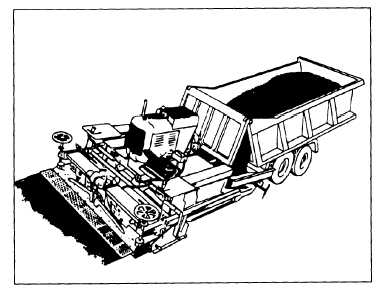width of the road being paved. It is then struck off to
the desired shape and thickness and compacted. Three
general methods of spreading and shaping the material
are in use today: hand spreading, blade spreading, and
mechanical spreading.
HAND SPREADING.— Hand spreading is the
oldest method used to spread and shape the mixed
material. For this method, the mix is dumped from the
trucks onto dump boards from which the material is
shoveled onto the road or runway. After placement, it
is raked smooth to grade and contour and compacted
with a roller.
WARNING
Asphalt and bituminous materials contain
coal tars, benzene, and other components which
are suspected or known carcinogens. Workers
should avoid inhalation of the vapors and
prolonged skin contact with these materials.
Review the Materials Safety Data Sheet
(MSDS) for specific hazards and precautions.
Because of the high cost of labor and the inability
to obtain a smooth and even-textured surface, hand
spreading is not used to any great extent. It is used
primarily to supplement the other spreading methods.
For example, hand spreading is used effectively for
adjacent curbing and around manholes.
When placing the material by hand, you should be
extremely careful to prevent segregation of the mix. Do
NOT throw the material a long distance and do NOT
dump it from too great a height. Dump the material in
small piles and level the material with shovels, rakes,
and lutes. Use the shovel to move the excess material
and the lute and rakes to level it. The material should
be as level as possible before compacting it.
BLADE SPREADING.— Blade spreading is done
with a grader by a skilled operator. The grader blade can
obtain reasonably good surface smoothness. Each
successive pass of the grader blade reduces the
irregularities in the surface. Often, blade spreading is
used in areas too large for hand spreading and
inaccessible to mechanical spreading.
MECHANICAL SPREADING.— Specialized
machines have been developed to spread bituminous
paving materials. Self-propelled, these machines have
crawler, wheels, or rollers which run on the base course
foundation or surface.
The mix from the plant is
dumped into a hopper on the front of the paver. The
paver places the mix evenly on the road itself. Figure
16-6 shows a bituminous paver that can handle any type
of asphaltic mix.
Compacting Plant-Mix Materials
The most important phase of flexible pavement
construction is compaction. When the specified density
of asphalt pavement mix is not obtained during
construction, subsequent traffic will further consolidate
the pavement. This consolidation occurs principally in
the wheel paths and appears as channels in the pavement
surface.
Most mixtures compact quite readily when they are
spread and rolled at temperatures that assure proper
asphalt viscosity.
Rolling should start as soon as
possible after the material has been spread by the paver
but should be done with care to prevent unduly
roughening of the surface.
Mix temperature is a principal factor affecting
compaction.
Compaction can only occur while the
asphalt binder is fluid enough to act as a lubricant.
When it cools enough to act as an adhesive, further
compaction is extremely difficult to achieve. The best
time to roll an asphalt mixture is when its resistance to
compaction is the least, while at the same time, it is
capable of supporting the roller without excessive
shoving of the asphalt material. The best rolling
temperature is influenced by the interparticle friction of
the aggregates, the gradation of the mix, and the
viscosity of the asphalt; therefore, it can change if any
of these factors change. The critical mix temperature in
Figure 16-6.-Bituminous paver.
16-11


